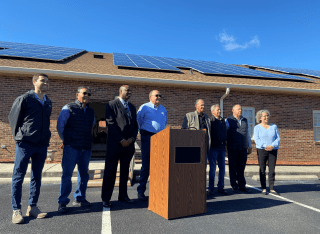
Home Fossil Energy Would permitting reform get rid of the red tape for U.S. energy infrastructure projects?
While proposals to expedite infrastructure projects are making the rounds in Congress, Wood Mackenzie, an energy intelligence group, believes permitting reform could be part of the solution to the strains created by rapid growth in renewables, as this could help ease U.S. grid bottlenecks.
Illustartion; Source: Wood Mackenzie
In these turbulent times, marked by a global energy crisis, which has ushered in the energy trilemma, the U.S. policy goals – encompassing the security of energy supply and climate action – are being put under the microscope. This is due to many being of the opinion that they are being impeded by overlapping obstructions to investment in infrastructure with the difficulty of building new grid infrastructure emerging as a roadblock to the surge in investment in wind and solar generation and battery storage, planned as a result of the Inflation Reduction Act (IRA).
Recently, the American Petroleum Institute’s report underscored that the U.S. was lacking the export infrastructure needed to help other countries with their energy woes and the infrastructure required to move energy from production areas to refineries and processing facilities and afterwards to domestic consumers, including new natural gas and oil pipelines and investment in maintaining existing infrastructure. As a result, API sees permitting and review delays as the main roadblocks in building this infrastructure.
Furthermore, API’s report showed that ten major infrastructure projects, reflecting $34 billion in capital expenditures, were cancelled, stalled or were at risk of cancellation due to permitting and review delays in recent years while 20.9 billion cubic feet per day (bcf/d) of non-FTA export permit applications were awaiting government approval. Therefore, the U.S. should accelerate liquefied natural gas (LNG) projects and lift supply chain bottlenecks, ensuring “the free flow of energy and commerce by expediting LNG project approval, lifting steel tariffs and relieving port congestion,” emphasised the report.
In line with this, a Rystad Energy study found that lifting development restrictions on federal lands and waters could add 395 million barrels of oil equivalent (boe) of production through 2035, which equals, on average 77,000 boe/d from 2023-2035 and nearly $29 billion in investment in the U.S. economy. In addition, energy development could generate $4.8 billion in government royalties, taxes and lease bid revenues from 2023-2035.
Wood Mackenzie’s Ed Crooks, Vice-Chair Americas, outlines that attempts to reform the federal law on permitting for infrastructure, including power transmission as well as other projects such as pipelines and LNG terminals, foundered in Congress last year, despite support from President Joe Biden. However, Crooks explains that fresh attempts at reform are being launched in a new Congress with Republican control of the House of Representatives.
As House Republicans have put energy at the heart of their policy programme, proposing about 20 separate pieces of legislation intended to boost domestic production and strengthen the security of supply, Wood Mackenzie believes that a window is opening for possible legislation, with support from both parties, that could reset the balance between developers seeking to build infrastructure projects, and those seeking to stop them.
In recent weeks, two bills, which differ in scope, have been proposed: the Building United States Infrastructure Through Limited Delays and Efficient Reviews (BUILDER) Act, and the Transparency, Accountability, Permitting and Production of (TAPP) American Resources Act. While the BUILDER Act is focused on reform of the 1970 National Environmental Policy Act to streamline and accelerate environmental reviews and limit subsequent legal challenges, the TAPP Act includes those provisions, as well as a list of other measures covering issues such as federal leases for oil and gas development, royalty rates and drilling permits.
According to Wood Mackenzie, both of these bills are “significantly” different from the proposals put forward last year by Senator Joe Manchin that included measures aimed specifically at expediting electricity grid investment, which the Republican plans do not have.
Despite this, the core principles of streamlining reviews and limiting challenges are the same, thus, Crooks believes that there is “a real chance that some kind of compromise can be reached that will win sufficient support from both Republicans and Democrats, and be signed into law by President Biden.” This compromise reform plan could face opposition from environmental groups.
Wood Mackenzie claims that the number of new requests for interconnection rose every year from 2013 to 2021 with the majority of the projects being solar generation, battery storage, or hybrid solar-plus-storage. As of the end of 2021, there were 8,133 projects waiting in interconnection queues in the U.S., with a total generation capacity of over 1,000 GW and output from storage of 420 GW.
Crooks highlights that more than 90 per cent of that generation capacity was in low-carbon energy. Additionally, the typical time between a request and an agreement for interconnection has also been rising from about 18 months in 2015 to over three years in 2021.
By expanding and extending tax credits for wind, solar and storage, Crooks points out that the Inflation Reduction Act seems set to make those congestion problems worse because there will be more projects that are economically viable and aiming to get connected to the grid. In light of this, Wood Mackenzie analysts have estimated that to reach the goals of the IRA, the U.S. will need $80 billion – $100 billion in transmission investment, but the act’s provisions relating to transmission do not guarantee that those investments will be made.
Ryan Sweezey, Wood Mackenzie’s principal analyst for North America power and renewables, remarked: “You can see the IRA as the latest step in a long tradition of Congress ignoring everything except generation. Money is not the problem. There is clearly an economic rationale for more transmission. The real issue is the legal and regulatory structure we have that is antithetical to long-term transmission planning.”
In a bid to demonstrate how grid constraints could affect the impact of the IRA, Wood Mackenzie’s analysts modelled a ‘decarbonisation headwinds’ scenario, reflecting a future in which obstacles to transmission development and growing interconnection queue bottlenecks raise costs for a new generation and limit the pace of decarbonisation in the electricity sector.
In that scenario, the U.S. has about 330 GW of utility-scale solar generation capacity in 2033, which would still represent very rapid growth from about 63 GW in 2022, but it is well short of the figure of about 420 GW Wood Mackenzie forecasted in its base case last year.
Moreover, if permitting reform gets the green light, Wood Mackenzie concludes that it could help smooth the path for power transmission investments and the growth of renewables in the United States, but “it is not a magic wand.”
To this end, Sweezey cautions: “Permitting reform will certainly make a difference. But it is just one of the many issues that need to be addressed. Independent system operators, the Federal Energy Regulatory Commission, state regulators, inter-regional planning, and cost allocation: all of these will need reforms to realise the full potential of renewable energy in the U.S.”
Following concerns in the EU about the Inflation Reduction Act’s ability to put the spotlight on the U.S. for investment in low-carbon energy technologies, the European Commission set out an amendment to the EU’s state aid rules, making it easier for member states to support key industries for the energy transition.



